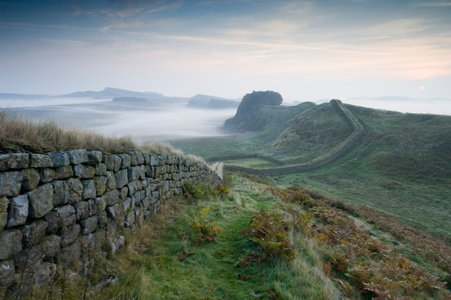


Great Walls of the World
The Great Wall of China may be the headline grabber, but there plenty of other ‘great’ walls in the world that are waiting to be discovered – from ancient historical sites thousands of years old, to recent urban constructions – they all have a story to tell.
Hadrian’s Wall – England
When visiting Hadrian’s Wall, in the north of England, it’s not so hard to be taken back thousands of years to its construction, in a time of battle and conquer. The heavy cobbled stones that make up the wall remain perfectly intact and seemingly undisturbed, winding through the rolling greens of the English countryside for nearly 120 kilometres. The wall was built by the Romans in order to protect their colony from invasion by neighbouring tribes in Scotland, and it’s said to be one of the most heavily fortified borders ever constructed by the mighty Empire. Much of the remarkable preservation of Hadrian’s Wall is thanks to antiquarian John Clayton, who bought up many sections in the 19th Century, and the Wall is now a UNESCO World Heritage Site. For those feeling particularly energetic or adventurous, the entire length of Hadrian’s Wall can be covered through walking or cycling, with an adjacent path stretching from Wallsend to Bowness-on-Solway.
Berlin Wall – Germany
The history behind the construction, and symbolic fall of the Berlin Wall is well-documented – built in 1961 to prevent residents of then-East Germany from fleeing to the neighbouring West. The fall of the Wall in 1989 is a memory that remains etched in the minds of many people today, as the nation of Germany was reunified. Although much of the dreaded structure was physically dismantled almost immediately, the remaining 1.5km that still stands has become an iconic tourist attraction, a symbol of freedom, and an open air museum of sorts. Much of the remaining wall has become what’s known as the East Side Gallery, which is a 1.3km stretch of more than 100 diverse, intricate and brightly coloured peace murals painted on the Wall.
Walls of Ston – Croatia
The Walls of Ston wind through the picturesque mountains of Croatia for about seven kilometres. Like many other ancient walls, they were constructed as a defence. In this instance, it was to protect the nearby city of Dubrovnik, with its precious salt pans. These salt pans were extremely valuable, because the mineral was in very short supply during the 15th century. The Walls of Ston have a charming, medieval aesthetic, with some 40 towers and five fortresses on the path between the small towns of Ston and Mali Ston (Little Ston). The Walls are colloquially known as the ‘European Wall of China’, and form the longest remaining fortress anywhere in Europe. The town of Ston itself is a beautiful place to visit, situated along the Dalmatian Coast, and with dramatic green clifftops plunging into perfect turquoise waters. The medieval theme of the walls also remains evident in Ston itself, with uneven cobblestone architecture transporting visitors back to the 14th and 15th Centuries.
Belfast Peace Lines – Northern Island
The Belfast Peace Lines, like the Berlin Wall, are a symbol of a city divided, and coloured in political murals in some sections. The Belfast Peace Lines in the Northern Irish city separate Catholic and Protestant neighbourhoods. Originally intended as a temporary measure when first erected in the late 1960s, the Lines have not only remained but increased, from 18 to around 40 today. The Lines are walls made from various materials, including brick, iron and steel, and stand nearly 8m high in some sections. Although Belfast is now largely at peace, there has been much debate within the city about removing the lines, or otherwise, with a ‘Peace Gate’ being opened in Alexandra Park in September 2011. A visit to the Peace Lines provides a fascinating insight into current and ongoing history, whatever your take on the conflict.
Diyarbakir Walls – Turkey
The old city of Diyarbakir in Turkey is encircled almost entirely by a dramatic perimeter wall made of black basalt. The Diyarbakir City Walls are one of the longest remaining medieval fortifications in the world, with a circumference of more than five kilometres, thought to be second in size only to the Great Wall of China. The entire construction has been remarkably well-preserved, with the four original gates to the city remaining perfectly intact, and more than eighty watchtowers scattered at various vantage points throughout the length of the walls. The walls of Diyarbakir were constructed and then extended by Roman Emperors Constantius II and Valentinian I respectively, and the entire city retains an historic, ancient-stone style of architecture to this day.
Great Wall of China – China
No list of the great walls of the world would be complete without the Great Wall itself. Winding more than 8,500 kilometres from eastern to western China, and easily surpasses every other wall in terms of length, and every other structure in the world for sheer size and scale. The Great Wall is in fact made up of several walls, that were constructed at various points in history from around 221BC, during the rule of four different Chinese emperors. It can be difficult to decide exactly which part of the Great Wall to explore, as there are so many options. One of the most popular sectors is located in Badaling, due to its proximity to Beijing, and ease of climbing. The Mutianyu sector is further from Badaling, but is quieter and features stunning mountain scenery. If you’re feeling more adventurous, there are various hikes available, including the Jianshanling to Simatai trek, a 10km journey which explores some of the Wall’s older, unrestored sections.
Start planning a trip to the world’s most iconic venues with your local, personal travel manager. Visit http://www.travelmanagers.com.au/ptm-search/